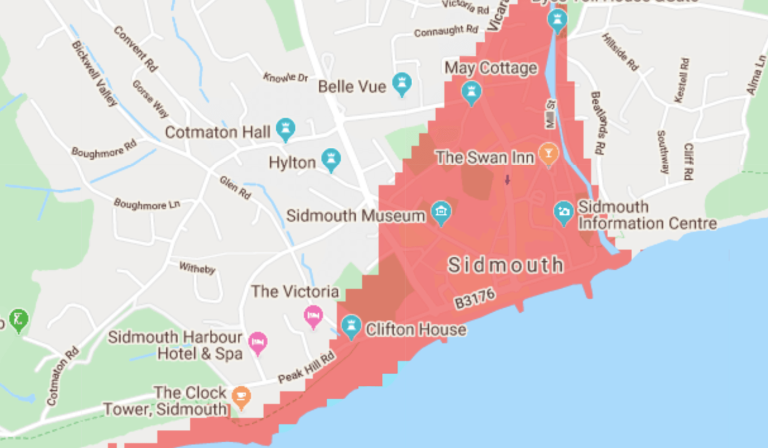Flood maps for the Sid Valley – areas of high and low risk
.
Maps of the ‘risk of flooding’ for Sidmouth town centre were produced in 2019:

Flooding prediction for swathes of East Devon and Exeter is played down
These were indeed quite dramatic – and showed the ‘worst case scenario’.
Nevertheless, the official flood plan shows an area which is not so different:
Sidmouth flood plan : public information leaflet | environmentdata.org
As is also shown in the flood map – which indicates areas of high and low risk:
The county council has just released a video on the creation of its latest plan:
How the Sidmouth Flood Alleviation Scheme was planned – YouTube
First phase of Sidmouth flood alleviation scheme officially opened – News
And in the meantime, the VGS has received a piece from the Creative Media team, looking at flood preparation and safety:
” Flooding can feel like something that you just see on the news, but the truth is that it’s a reality for many people across the world, especially in the wake of rising sea levels due to global warming. Whilst you can get a full home survey when you buy a property, which includes information about the flood risk, people who have lived in their home for many years may not realise that they have become at risk.
If you’re concerned about flooding, you can use the government website to check if your home is considered at risk. However, no matter what risk level you are at, it’s worth knowing what to do in the event of extreme rain. Here, we take a look at some simple steps you can follow if there is a flood in your area.
Sign up to flood alerts
A quick and easy way to make sure you’re staying up to date with any flood issues is to sign up for flood warnings by email, phone, or text. This service is provided by the government, and if you live in an at-risk area, the alerts are free. You can also check for warnings online, which are forecast for the next five days or check #floodaware on Twitter.
Don’t ignore flood alerts. You may think that a small amount of water won’t affect you, but in fact, just 30cm of water can move cars, and shallow water can easily make you unstable and knock you off your feet. It’s always better to be safe than sorry.
Personal flood safety plan
After reading the flood warning, you should put your flood plan into action. Make your home as secure as possible, and contact family and friends who live nearby to check that they have had the alert and ask if they need any help with their own homes. You should also make sure that your phone is charged in case you need to leave quickly, and charge up any battery packs in case you can’t get to a plug when you need it.
Pack an emergency bag for all members of your family. Remember that you’ll need to carry this, potentially on your back to get it above the water level, so opt for a rucksack if possible. You should also create a central grab bag for your family, including bottled water, a first aid kit, and snacks.
Store your valuables safely
One of the devastating effects of flooding is beloved items getting damaged. These could be items that have a lot of monetary value, or it could just as easily be photos or documents. If you know that your home is at risk of flooding, store these items in a secure, waterproof container, and label them clearly. This may help reduce the damage if you’re not at home to get the box out, or the labelling will help you find the important items you need to grab in an emergency.
To sum up
Even if you don’t live on the coast or next to a river, there’s never any harm in being prepared for a flood. By signing up for alerts, storing valuables safely, and being able to throw a grab bag together, you can give yourself the best chance of protecting your family and your home in the event of an emergency.
Visit this website to find out more about flood safety and resilience:
- https://check-long-term-flood-risk.service.gov.uk/postcode
- https://www.comparethemarket.com/home-insurance/content/flood-safety/
- https://nationalfloodforum.org.uk/about-flooding/preparing/emergency-flood-kit/ “
.
.
.